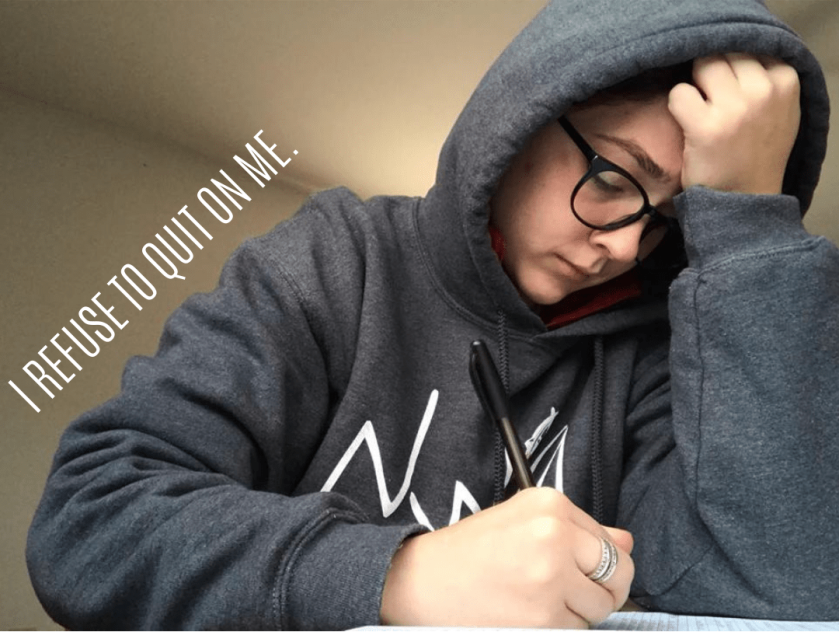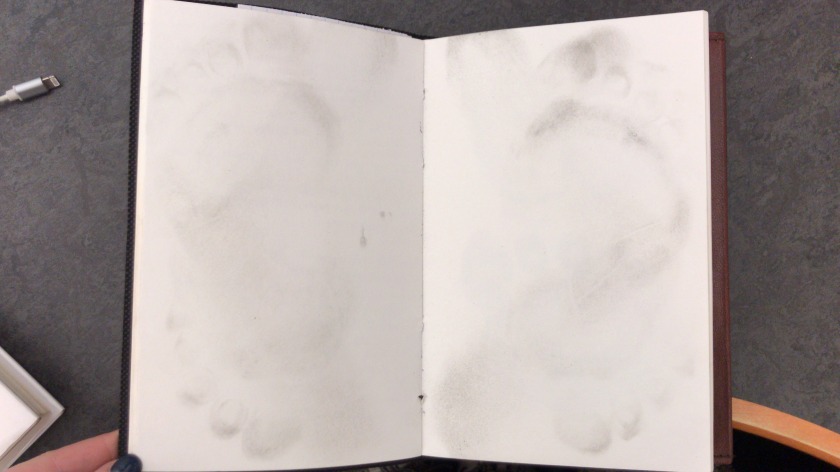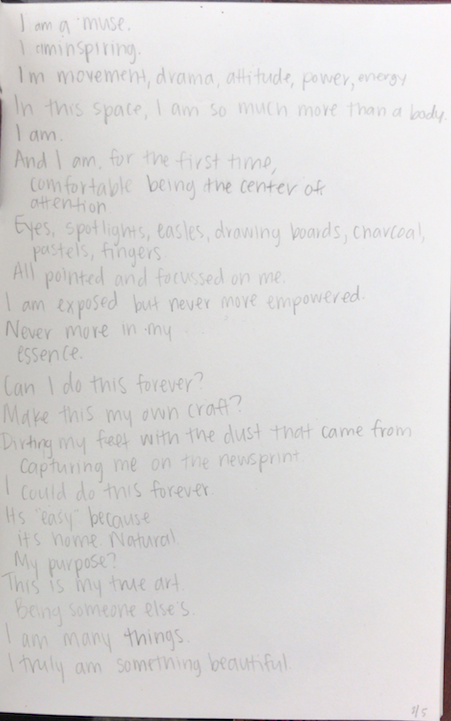Just to start off, I will say that I am going into this reflection completely unaware as to what I am going to say. After my readings this week I truly do not know what to say or how to respond to what I took in. That is not saying that what I read did not engage me or illicit a response from me, but I do not know what there is to say in a written blog post about all of it.
Well, maybe I am more confused as to how to respond to Brown Girl Dreaming because it was a text that challenged me as a reader. Whenever I read poetry or verse I find myself stuck in my confused high school approach of constantly looking for meaning in everything I read and how it is presented, although I never believed any of that when I was in school (which is what resulted in my confused state of mind). I feel that I “missed” something even though I know what was happening in the story thus far (have read up to the end of part 1).
I found myself reading Jacqueline Woodson’s words as a novel instead of in verses. I took pauses when they fit, but wasn’t sure if they enhanced my reading of the text or not. She spoke of her birth, her name and the name(s) behind hers, of her family before during and after her birth, her home/s, and the world that was moving as she was growing. Beautiful words and segments of her life portrayed in short snippets and glimpses of time through chapters/verses.
As a reader, I believe I struggled because I went in to the text knowing only that it was a novel in verse and that a middle school English teacher friend of mine used it in the Fall and her students loved it. I didn’t have much of any introduction to the text or the author or how I was to go about reading it. Now, I doubt if any of those things would have helped me in my reading, but even while writing this I feel as though I need to reread it all several more times to accurately read what Woodson was telling.
As a writer, I enjoyed the flow of the words across the page as they filed into the next and did not interrupt thoughts mid-line. How she interspersed lyrics from songs playing during a memory into the text. It made me try to think back to memories of my own and if I can remember the background of what was happening or if my focus was only ever on what was in front of me. Music certainly can trigger memories, but I wonder if exploring memories can trigger deeper recollection of what happened.
Now that I think about it, I wonder if I were to scroll through music that I listened to or heard from my youth, if I would remember a small memory that has since faded. Actually yes, I will add that to my writer’s notebook as something to explore further. I know there are certainly smells that evoke memories, but some of those would be hard to explain to anyone except for my own mind…good thing it’s my writer’s notebook.
***I will come back to further reflect on this reading experience (and writing experience) after I have read part 1 again and fully understand my reading of it***
UPDATED (2/5/19)
Well I am very happy that I came back to reread part 1 of this text because, wow. Not only was I more focused on Jacqueline’s words, but the history and power embedded in what she was sharing. The authenticity and honesty. And the history not just from her personal life story, but the history of her family, and the history of the world that she was born into and grew up in.
While reading I decided to take notes in my writer’s notebook so I will always have a record of my in-the-moment thoughts, reactions, and connections while reading, as well as quotes, stanzas, words that stuck with me. This is how I attempted to approach the novels I was reading during the Fall, but it became too overwhelming. However, with a text such as this (novel in verse) that is not dense in its word count but rather in the stories within the words, these notes are most compatible for me.


My connection to pg. 33 still remained in my second reading, but a new one also appeared: the role of grandparents. In my first reading, I don’t remember much about Jacqueline talking about her grandparents outside of a brief mention during the pages of when her grandmother was talking about the time of the day she was born. But again, because I was more focused and intentional in my reading, I experienced new connections.
I have never had the typical relationship with grandparents that so many people talk about or share through memes/social media threads. Both of my daddy’s parents passed away before my brother was born, so neither of us got to meet them. And my momma’s parents have been divorced since she was a kid; Pawpaw married twice more since then and Memi never remarried (he was her third husband and Momma always says that Memi said three was plenty).
I never experienced the “when mom says no, go ask grandma because she always says yes” or “when you go to your grandma’s house, she’ll shower you in food even if you’ve already eaten”. Yeah, no. My brother and I never got to stay at her house when we were younger if my Aunt wasn’t there because (and this is not a tearing down of my Memi because I love her SO much and her upbringing and third marriage had large impacts on her) Momma wanted to ensure that there was someone to remember to feed us.
However I am getting to experience a similar relationship with my Great Aunt and Uncle. They treat my momma as if she was their own, and my brother and I as if we are their grandkids. Family relations, whether blood or not, can change and morph over time. They come to fit the needs that you have and fill the roles you didn’t know you didn’t have.
I do wonder what my daddy’s parents would have been like, though. Jesse is named after our paternal grandfather, and when comparing some pictures of him to Nancy when she was younger, there are some strong resemblances (not much of a strong resemblance with me and either of them; I more resemble family on my momma’s side — now that would be a fun entry to make: family resemblances and inherited traits). Daddy doesn’t talk about his parents much, but when I go back home in March, I would love to sit down and ask him about them a bit. He was really close to mom, so I’m sure there will be many emotions, and I feel like she would have been an amazing woman to meet and have as my grandmother.
###Never be afraid or nervous to admit that you weren’t paying attention what you were reading. And certainly don’t lie about it. Be honest with yourself and learn and grow from it. I could have simply left part 1 after my initial reading like I used to do in similar situations. But something about the text kept calling back to me to come back and read it again. And it’s ok to be upfront about not knowing how to reflect or respond. Confusion can lead you to new discoveries and starting points. It can unearth revelations about ideas and can even clear up parts of confusion. But it starts with being honest with yourself. It’s not wrong or a mistake. It is a never ending learning process that grows and develops with you if you allow it to.###
This week I continued reading in Textbook Amy Krouse Rosenthal (TAKR). What was different this time was instead of responding to the text on paper as I was reading, I started a list in my writer’s notebook of inspiration/ideas I got from the section (pages 60-101).

Some are directly related to what she had written, and some were expansions of my thought process as I was reading. One that I immediately started to write was the food associations, but I didn’t even take it the way that I had written on this list. Instead, I made a candy association list of my family and my partner (and myself). I had realized that there were candy associations that I knew were wrong but didn’t know what the real choice was [was listing each person’s favorite candy], and there was one that I honestly had no clue about.
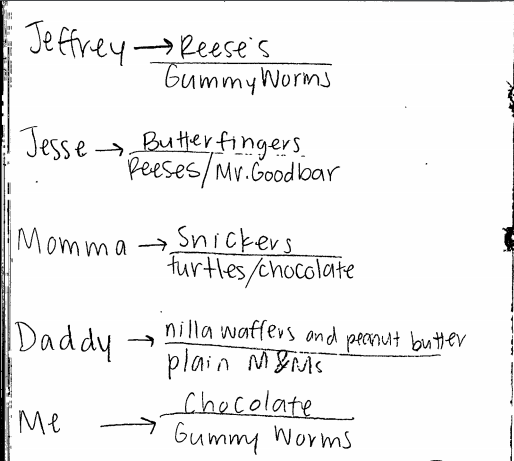
But after making my list of what I thought/once knew was their favorite candy (excluding my partner because I already knew that correction) I texted them and asked them what their favorite candy actually was. And what’s really funny is how they all responded.
My dad just flat out told me his answer and then inquired as to why I wanted to know.
My brother sent three separate texts: “Probably reese’s nowadays”, “Or mr goodbar”, “Honestly anything that has peanuts and chocolate”. And then immediately followed it with a change of topic of his cat (one of three cats at home, but Peel is very attached to him).

And my mom, which is how I know I truly know I’m her daughter, said “Turtles…chocolate…anything…” because she and I both will have a main favorite, then a large category, but honestly we love it all.

{in case you wondering, and even if you weren’t, I add emojis to the names of people close to me in my phone. Daddy has a hammer because he works in construction, Jesse has both whale emojis because he loves them and has even drawn himself as one (lots of stories and inside jokes about him and whales), and Momma has a crown because…she’s the queen of queens and is everything to me.}
Now, my original idea/inspiration was to talk about how not only do people associate you with something that they think you love, but they also associate you with something they think you don’t like. And my initial example was how for the longest time (and sometimes she still does), my mom thought I didn’t like Peanut M&M’s so she would always buy a pack of plain or me or something else when she got the Peanut brand. Now, I’m not saying I was mad at this, because she has always gone out of her way to treat my brother and I fairly and equitably. It showed me that she was thinking of me and wanted to find something I would enjoy. Only thing is…I love Peanut M&M’s (they’re not my favorite candy though…I will take a bag of gummy worms any day over them), and I can’t remember when she had the idea that I didn’t, or what I may have said to make her think that. It’s just interesting how she came to associate that with me and how she would go out of her way to still include me in candy runs.
From this list, I also expanded upon what I had initially written with reasons as to why I had those associations with them.
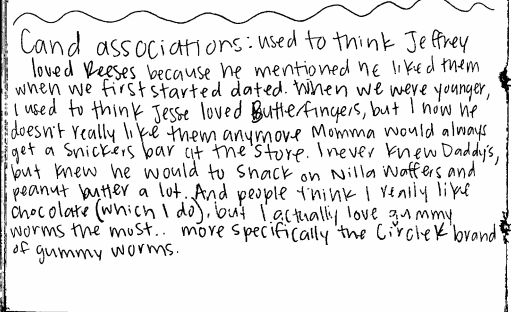
And just from this exercise I found out even more how mentor texts can be mentors that sprout memories and ideas that were once “forgotten”. Pulling from an author’s ideas and memories and finding even the smallest connection to bloom into a tangent of my own really does fill my cup. Just now I was thinking of a memory that always fills my cup when I think of it. And it’s one of those memories where you had to be there in it to get the full scope of it. Because all it was was laughter. Laughing in the car with my mom and brother after we stuffed ourselves silly at Friendly’s in Myrtle Beach. Laughing because we stuffed ourselves silly and we could not believe how much we had ate. Laughing over everything we ate and then laughing some more because we realized that momma had started slowing down while driving because we all had tears in our eyes and could barely see anything through the slitted openings where all there was was the fuzzy outlines of the street lights that night. Now that is a memory that I wonder about someone’s connection to. And when I say “connection” it doesn’t have to be directly related to anything that was in that memory.
Do you have any food or candy associations with people in your life? Are they likes? Dislikes? Obsessions? If you do, go out and see if you’re right. If not, try to think back to why you have that association and see if you can follow a memory through that association.
From a teacher of writing stand point, a couple of things stood out to me in my reading of Mentor Texts this week. In the chapter, Rose and Lynne discussed how we can help students discover personal stories by connecting them with the literature in our classroom. Now, of course that’s what we aim for and have planned for in our instruction. But the ways in which it can be done stretched farther than I thought.
First point was this statement
“Read-alouds do not always have to be whole books. They can be one or several passages from a chapter of a more lengthy text, including those intended for older audiences, as well as excerpts from magazines, newspapers, catalogs, and travel guides.” (Dorfman & Cappelli, 2017, p. 24)
Which had me thinking about all of the literature that I enjoy but never thought I would be able to share with a class because it was written for older audiences. But when the writing speaks to you and evokes emotions that draw from personal connections, that’s when you want to share it! And you can easily introduce the texts to your class by working to build the connections they have in their lives to the lives and experiences of the characters in the text. Just as you would with any other text. You are bringing them in with the purpose of connecting them to help them understand and to dig for their writing treasures (their personal connections, observations, anecdotes, and discoveries that they put in their writer’s notebooks).
And the second point that stood out to me from a personal standpoint was this:
When using photos as a vehicle for finding writing topics, it is important to model for students that the story must be theirs, not one told to them by someone else such as their parents or grandparents. (Dorman & Cappelli, 2017, p. 33)
And this probably makes complete sense to anyone else who reads this. But for me, I grew up hearing all of the stories that my parents told me and my brother as they showed us pictures on the walls and from boxes. These stories were told over and over again and they were ingrained in my brain. I always wanted to share the stories but knew I could never do them justice. And not because I wasn’t there when they happened, but because they weren’t my stories.
However, the stories that I do have to share are those of sitting there listening to their stories, looking through the pictures and comparing them through the years. Finding the slightest bit of resemblance from generation to generation. From one side of the family to the other. And noticing how sometimes the retelling of certain stories change ever so slightly with more detail or even new details. How I don’t get tired of hearing the same stories over and over because I don’t know how much longer I’ll be able to hear them be told to me.
And that is something I plan on sharing with my students in addition to modeling that the story must be theirs. That they are constantly gathering stories to remember and write (and maybe share) and to enjoy the storytelling while they do, no matter how many times they hear it. Maybe even reflect on the storytelling experience and how the person telling the story feels when they talk about those memories. Even finding the connections with those emotions and experiences to something they may have felt similarly.
We gather stories forever. We share them sometimes. And we listen while we still can. The cycle continues because we are full of stories that inspire and empower others. That evoke emotions and feelings that may not have been intended. We make connections through our experiences and continue to fill our treasure chest (our writer’s notebooks) with the treasures in our lives.
References
Dorfman, L. R., Cappelli, R., & Hoyt, L. (2017). Mentor texts: Teaching writing through childrens literature, k-6 (2nd ed.). Portland, ME: Stenhouse.
Rosenthal, A. K. (2016). Textbook Amy Krouse Rosenthal: Not exactly a memoir. New Tork, NY: Dutton.
Woodson, J. (2014). Brown girl dreaming. New York: Puffin Books.




